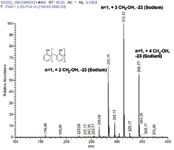Absolute Molar Masses for Phenol Formaldehyde Resins with GPC/SEC-ESI
LCGC Asia Pacific
Polymer Standards Service GmbH Application Note
Introduction
Phenol formaldehyde resins are synthesized by a step-growth polymerization. GPC/SEC with RI and UV detection is often used to characterize resins and to quantify the amount of different oligomeric species. Additional information can be obtained if an ESI-MS-spectrometer is added in-inline to the GPC/SEC system. This technique combines the separation ability of GPC/SEC with the sensitivity and specificity of detection from MS and allows the identification of oligomeric species and gives information about the degree of CH2-OH substitution.
Experimental
GPC/SEC analysis was performed on a PSS SECcurity 1200 System consisting of:
- an isocratic pump
- an autosampler with variable injection volume
- a differential refractometer (RI)
- a Thermo Fisher LXQ ESI spectrometer

Figure 1: RI trace oligomeric phenol formaldehyed resin, degree of polymerization identified from corresponding mass spectrum.
Conditions:
Columns: PSS SDV, 5 μm, 8 × 300 mm; 50 Å, 100 Å, 1000 Å, precolumn
Solvent: THF
Flow-rate: 0.3 mL/min
Inject volume: 20 μL
Software: PSS WinGPC Unity 7.4, Thermo Fisher Excalibur 2.07

Figure 2: Mass spectrum for n = 1 showing the 3 different species (CH2 âOH substitution).
Results
Figure 1 shows the elugram of an oligomeric phenol formaldehyde resin, separated into three different peaks with 1, 2 and 3 repeat units. The mass spectra are then measured for each species. Figure 2 shows as an example the mass spectrum for peak n = 1 while Table 1 summarizes the masses possible in theory and identified (green) or not detected (grey). This combined approach can be used for molar masses up to approx. 2000 Da, higher degrees of polymerization have also been investigated.

Table 1: Expected molar masses for different degrees of polymerization (n) and for CH2OH units at the aromatic ring. Colour code: grey: possible in theory but not found, green: identified in MS spectrum.
PSS Polymer Standards Service GmbH
In der Dalheimer Wiese 5, D-55120 Mainz, Germany
tel. +49 6131 96239 50 fax +49 6131 96239 11
E-mail: fgores@polymer.de
Website: www.analyzepolymers.com

A Novel LC–QTOF-MS DIA Method for Pesticide Quantification and Screening in Agricultural Waters
May 8th 2025Scientists from the University of Santiago de Compostela developed a liquid chromatography quadrupole time-of-flight mass spectrometry (LC–QTOF-MS) operated in data-independent acquisition (DIA) mode for pesticide quantification in agriculturally impacted waters.
Investigating 3D-Printable Stationary Phases in Liquid Chromatography
May 7th 20253D printing technology has potential in chromatography, but a major challenge is developing materials with both high porosity and robust mechanical properties. Recently, scientists compared the separation performances of eight different 3D printable stationary phases.

.png&w=3840&q=75)

.png&w=3840&q=75)



.png&w=3840&q=75)



.png&w=3840&q=75)









